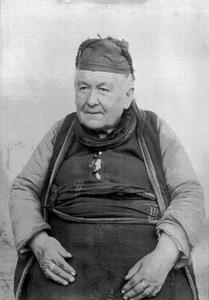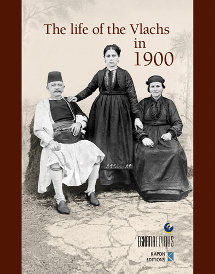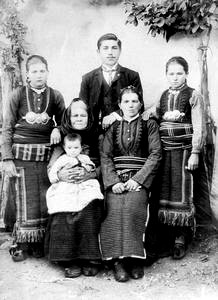THE VLACHS: METROPOLIS AND DIASPORA
II. The Vlachs of Zagori and Konitsa
3.2.2. The debate about the former extent of Vlahozagoro
 According to one out-dated view, the Vlach villages in Zagori were established in the fifteenth century. Aravandinos, the proponent of this view, includes Negades, Tsepelovo, and Tristeno among them, which allows us to suppose that the Vlach settlements in Zagori covered a much greater area then than now, because these villages seem to have been occupied by Greek-speakers for many generations. What Aravandinos says may be a good starting point for research and debate regarding the former extent and number of the Vlach settlements in Zagori.[1]Lambridis also offers support with the view that the Vlach settlements in Eastern Zagori once extended towards Central and Western Zagori. Villages such as Leptokarya (Liaskovetsi), Kavallari, Negades (Neagan or Neatsiani), Frangades (Frindzi), Tsepelovo, and Skamneli reportedly were once inhabited by Vlachs or at least also by Vlachs. Furthermore, some village names and a number of place-names throughout almost the entire area seem to have a Latin/Vlach root, thus supporting this view. Examples include Skamneli, Vradeto, Koukouli, Baya (now Kipi), Siopotseli (now Dilofo), and Tservari (now Elafotopos).[2] The anthropological medley of Vlach-speakers and Greek-speakers in the villages of, mainly, Central Zagori is also reflected in the Vlach customs which apparently survived there, even after any Vlachs in their populations had been assimilated by the probably more numerous Greek-speakers.[3] Furthermore, when Weigand visited the area at the end of the nineteenth century, he reported that some elderly inhabitants of Tsepelovo, Skamneli, and Dilofo understood Vlach, though the rest were now Greek-speakers. Weigand’s observation must reflect an actual situation, indicative of the assimilation of Vlach-speaking groups among the mainly Greek-speaking inhabitants of Central and Western Zagori.
According to one out-dated view, the Vlach villages in Zagori were established in the fifteenth century. Aravandinos, the proponent of this view, includes Negades, Tsepelovo, and Tristeno among them, which allows us to suppose that the Vlach settlements in Zagori covered a much greater area then than now, because these villages seem to have been occupied by Greek-speakers for many generations. What Aravandinos says may be a good starting point for research and debate regarding the former extent and number of the Vlach settlements in Zagori.[1]Lambridis also offers support with the view that the Vlach settlements in Eastern Zagori once extended towards Central and Western Zagori. Villages such as Leptokarya (Liaskovetsi), Kavallari, Negades (Neagan or Neatsiani), Frangades (Frindzi), Tsepelovo, and Skamneli reportedly were once inhabited by Vlachs or at least also by Vlachs. Furthermore, some village names and a number of place-names throughout almost the entire area seem to have a Latin/Vlach root, thus supporting this view. Examples include Skamneli, Vradeto, Koukouli, Baya (now Kipi), Siopotseli (now Dilofo), and Tservari (now Elafotopos).[2] The anthropological medley of Vlach-speakers and Greek-speakers in the villages of, mainly, Central Zagori is also reflected in the Vlach customs which apparently survived there, even after any Vlachs in their populations had been assimilated by the probably more numerous Greek-speakers.[3] Furthermore, when Weigand visited the area at the end of the nineteenth century, he reported that some elderly inhabitants of Tsepelovo, Skamneli, and Dilofo understood Vlach, though the rest were now Greek-speakers. Weigand’s observation must reflect an actual situation, indicative of the assimilation of Vlach-speaking groups among the mainly Greek-speaking inhabitants of Central and Western Zagori.
Skamneli in Central Zagori is a particularly interesting case. The site of the modern village must originally have been occupied by a small residential nucleus, neither large enough nor significant enough to be mentioned in an Ottoman register of 1564. Later on, possibly at the beginning of the seventeenth century, the inhabitants of the nearby settlements of Katouna, Ayios Yeoryios, Profitis Ilias, Tsepetsi, Kotsinades, and Nouka came and joined this original nucleus. However, this large influx apparently soon led to overpopulation and problems of survival. So in the mid-seventeenth century, some of the inhabitants went off to seek a better life mainly in Moschopolis, and also in Sopiki and Molitsa near Konitsa.[4] The number of people who left for Moschopolis at this time must have been quite large, because they are said to have established a new district there, which was called by the Vlach name of Skamnelitsili (‘the Skamneliots’ district’) and later came to be known as Skamneliki. A much more likely version of the facts is that the Skamneliots moved to Moschopolis not simply because of overpopulation and a desire for better conditions, but mainly because of the general sense of insecurity aroused in the inhabitants of the Zagori villages in the mid-seventeenth century by the frequent predatory raids conducted by bands of Arnauts. According to this version of the story, before the raids the above-mentioned settlements whose inhabitants went to live in Skamneli had, together with Skamneli itself, a population of about 800 families. Possibly after a much more ferocious raid than usual, some of the inhabitants fled to Moschopolis for safety. Moschopolis was chosen as a refuge not only because it offered security as a large, privileged town, but also because the refugees probably had family and professional connections with the inhabitants.[5] After the raids and the departure of the population, the only one of these settlements to survive seems to have been Skamneli itself, where the remaining inhabitants of the surrounding settlements must have congregated. According to yet another version of events, the Vlach contingent of the inhabitants of Skamneli and Tsepelovo originally came from Nouka (which means ‘walnut tree’ in Vlach), which was slightly to the east, in the area of Yiftokambos. This may mean that, before the various settlements which helped to populate Skamneli were abandoned, at least one of them, Nouka, was a Vlach settlement. According to local traditions, the first herdsmen who settled in Vradeto, reportedly around 1616, were from Nouka. Frequent intermarriage between Vlach-speakers and Greek-speakers in Zagori also brought Vlach inhabitants to various villages in Central Zagori.[6]
Following these ekistic and demographic shifts and changes, during the first half of the seventeenth century Skamneli must gradually have ceased to be regarded as a Vlach village, if it ever was (its name suggests that it was indeed). Athanassios Psalidas implies that the inhabitants of Skamneli were originally of Vlach descent when he writes, before 1821, that Vlach had long been forgotten there.[7] The fact that Skamneliots, possibly together with other Zagorites, left to establish a vigorous district in Moschopolis supports the view that the earlier inhabitants of Skamneli were perhaps partially of Vlach origin; though not all those who settled in Moschopolis in the seventeenth and eighteenth centuries were necessarily of Vlach origin. It must also be noted that the departure of the Skamneliots was part of the more general population drain from the Vlach villages in the Pindos during the seventeenth century. Apart from the Skamneliots, refugees from Metsovo and the surrounding area also arrived in Moschopolis in this period.[8]
Some studies include Leptokarya (Liaskovetsi) and Kavallari in Vlahozagoro, while others do not, but it is not easy to regard them as Vlach villages. However, information does exist that there were once Vlachs among their inhabitants. Leptokarya seems to have grown larger in around 1687, when people from the surrounding little settlements of Ayios Minas, Pades, Romnia, Megalo Dendro, Ayios Yeoryios, Sotiras, and some others further east came and settled there. Earlier records dating to 1732, or more probably to around 1769, state that a number of families from Moschopolis settled there, and were followed by some families from Fourka, who were certainly Vlachs. Those from Moschopolis reportedly brought with them some icons from the Church of St Nicholas in that town. In about the same period, migrants from Moschopolis and Fourka went to Tsepelovo and others from Fourka to Koukouli in Central Zagori.[9] Eventually, the various groups of Vlach-speaking families who added their numbers to the population of settlements in Central Zagori, such as Skamneli, Tsepelovo, and Leptokarya, were gradually assimilated by the much more numerous Greek-speakers; but their presence must explain why these villages are sometimes regarded as Vlach settlements and sometimes not.







